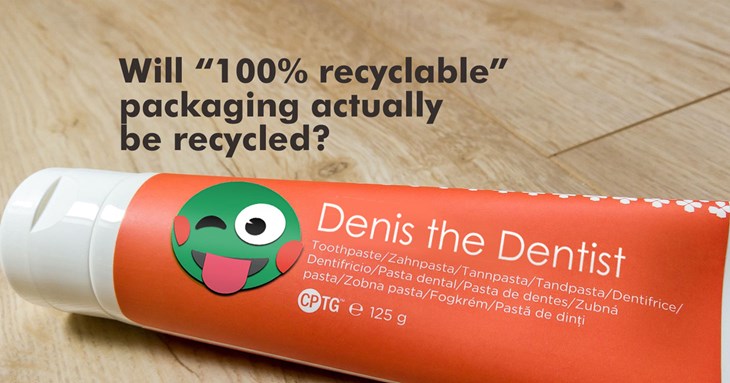Fully recyclable packaging - Denis the Dustcart Blog
Published: 16 November 2022

In his regular feature, Denis the Dustcart talks about fully recyclable packaging. Look closely enough and you’ll notice that more and more packing is being labelled ‘Now 100% recyclable’.
You can follow Denis on his Facebook page to keep up with information about Recycling issues.
Look closely enough and you’ll notice that more and more packing is being labelled ‘Now 100% recyclable’, or with some such other claim.
Toothpaste tube producers are among the latest to begin evolving their packaging composition away from traditional, problematic combinations of mixed materials and towards single-material constructions. On the face of it, making toothpaste tubes from high-density polyethylene (HDPE) – the same material as highly-recyclable and valuable plastic milk bottles – is certainly a step in the right direction and consumers are right to greet the introduction of these products with enthusiasm. But we need to take a bit of a reality check here.
Just because something is recyclable doesn’t mean it fits current recycling methodology and will actually be recycled, and the prospect of recycling companies and organisations developing infrastructure at huge expense to capture a minority of products among thousands of similar non-recyclable products just isn’t realistic.
An HDPE toothpaste tube might well be fully recyclable, but until all toothpaste tubes are made fully recyclable they are very unlikely to be picked off the recycling conveyor. It will be virtually impossible for staff on the line to tell, at a glance, which is a fully recyclable tube and which isn’t – and there aren’t resources available to pick off all toothpaste tubes, compile them separately from other materials and then go through them individually to separate the good from the bad.
It's essential that manufacturers pursue recyclable and sustainable alternatives for their historically problematic packaging, but realistically this needs to be extended to all (or the vast majority of) packaging in relevant ranges in order for recycling to actually happen. And the problem here is that it simply costs so much more to produce this packaging, and those costs must be passed on to the consumer – and not too many people at the moment will be willing to spend more for a recyclable packet.
And of course there’s the plastic tax to consider, whereby every piece of plastic packaging needs to contain at least 30% recycled polymer for the producer to avoid paying extra tax. On the surface this seems like a great incentive for producers to increase the recycled content of their packaging – or a great disincentive for them to stop introducing so much virgin plastic into consumer markets. Should this 30% threshold prove too difficult or expensive to reach, however, producers will be keen to avoid passing on additional costs to their customers, and an obvious way of achieving this would be by reducing the weight of their plastic – to use lighter, cheaper and therefore less recyclable plastic.
Standardisation is the key. When everything can be recycled, it will be; but while some things can be recycled that look the same as other things that can’t, they are unlikely to be recycled. Recycling plants will not adapt to capture a small number of items at significant cost and at the likely expense of more recyclable material.
It does seem that producers are beginning to take recyclability seriously, however – to realise that it isn’t enough to say their packaging can be recycled into park furniture via collections from drop-off points provided by volunteers in often inconvenient locations. Packaging needs to be made recyclable from home and the loop needs to be closed as tightly as possible.
Take plastic pop bottles: these are now being standardised to clear PET, meaning they can all be recycled back into clear PET bottles and trays where they are sorted well enough. Coloured bottles can only be recycled as part of a ‘jazz’ mix into limited products, but legislation in this case has now focussed attention on the quality of the product that the material we put in our recycling bins can become.
It isn’t up to recycling facilities to adapt at great expense to accommodate a minority of products that will provide minimal income. It’s the packaging that has to change, the producers who must assume responsibility for the waste their packaging becomes and the quality of the products it can be turned into.
Hopefully we are witnessing the beginning of a movement towards fully-recyclable packaging.
In the meantime, while we can’t guarantee that we’ll capture them for recycling, drop your HDPE toothpaste tubes in your green bin and we’ll do our best.

